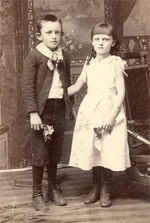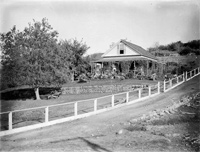Edith Irvine Collection
About the Collection
Biographical Sketch: Edith Irvine, 1884–1949

Lizzie Edith Irvine was born 7 January 1884 in Sheep Ranch, Calaveras County, California to Thomas Hanna Irvine and Mary Irene Hills.1 Thomas was undoubtedly a resident of Sheep Ranch, at the time of Edith’s birth, because of his occupation as a gold miner. Gold had been discovered in 1860 at the massive sheep corral—hence the name of the town. Patented in 1880, the town also boasted 15 saloons. 2 Calaveras County was a part of the California gold country found in the western foothills of the Sierra Nevadas.3
Edith’s grandfather, William Irvine, was the youngest in a family of nine children, all born in Ireland. In 1846 he immigrated to New York with his older brother, James. Both William and James went to California as a part of the 1849 gold rush and became miners. The brothers did well, especially James, Edith’s great uncle, who became prominent in southern California as the owner of the massive 110,000 acre Irvine Ranch in Orange County. He also developed a thriving produce and grocery business in San Francisco, along with real estate holdings, and after his marriage owned a home in San Francisco at Folsom and Eleventh streets. It is believed that Edith’s grandfather, William, was also successful in his mining ventures and in real estate.4 However, there is some indication that some of his success may have been through some dubious business practices. 5
When James Irvine died on 15 March 1886, he directed in his will that over $100,000 should be provided his wife, brothers, sisters, and other relatives through the liquidation of many of his properties. Substantial land gifts, not to exceed the value of $5,000 were also to be given family members from his holdings in southern California.6It is not known whether William received any funds, but certainly his son, Edith’s father Thomas, seems to have acquired property and some financial independence, perhaps as a result of his uncle James bequest. “Billy” Plunkett, Photoarchivist at the Lee Library in 1988, indicates in her master’s project on Edith, that the “family fortunes increased due to acquisitions of mines and other real estate,”and that the Irvine family became part of the “upper social strata of the area.”7 Edith apparently often visited with family members in San Francisco and southern California.

With her birth, Edith joined her older brother, christened as Robin Reddick, but known throughout his life as Robert or Bob, who was born 30 April 1882. They were close friends and companions throughout their lives. Perhaps that closeness came about in part because it was just the two of them, as a younger brother born 13 February 1886, Thomas Clinton, died in infancy. Edith remained single throughout her life and Robert didn’t marry until he was 60 years old—their marital status undoubtedly contributed to their closeness as the Irvine family continued to live together in the family home now in Mokelumne Hill, California, where they had moved. 8
It is unclear exactly when Edith became intrigued by photography, although in her early teens she had created a darkroom in a rear corner of the house in Mokelumne Hill, or Moke Hill as the natives call it. By the time she was fourteen, in 1898, she was already photographing the extensive Electra Power Project—the first hydroelectric power project in California. This project, near her home on the Mokelumne River, California, was completed in 1902. Family tradition says that Edith was hired as a photographer for this project by Standard Electric of California, the predecessor of Pacific Gas & Electric Company, but no records have been found to substantiate that.9 Her work at that young age is impressive in documenting a monumental civil engineering project.
Her next great photographic venture, and certainly the epitome of her brief photography career, came at the age of 22—documenting the 1906 San Francisco earthquake. Her compelling photographs persuasively draw you into the devastation and even humor of the earthquake experiences. In 1910 she considered herself a professional photographer as noted on the census, but for reasons unknown, by 1920 her occupation was school teacher.10
Anecdotal stories that “Billy” Plunkett gathered for her master’s project, indicate that Edith had long red hair and that she loved to ride her horses and drive her Model T Ford. In her later year no one outside of the family seemed to be aware of her photographs. But one of her former students characterized her as fair, but strict, and a good teacher. 11
Edith’s life was difficult both physically and emotionally. She apparently suffered from severe joint pains of unknown origin, which were treated by her doctor with painkillers. Later she lapsed into alcoholism—all of which caused severe mental deterioration as well as the expected physical deterioration. In addition she began to lose her hearing at an early age, until by 45 years old, she had become severely hearing impaired.12
She never recovered from the medical and emotional problems that she suffered from in her later years. Not long after her brother, Bob, was granted legal guardianship for her on 8 June 1949, she died at age of 65. It was with the donation of her small collection of photographs to the Brigham Young University Library in 1988 by her nephew, Jim Irvine, Bob’s son, that her photographic talents became known outside of her circle of family and friends. She had a gift and we are grateful to share her gift.
Footnotes
- The family names and birth dates were received from Jim Irvine, in a photocopy of a “Family Record.” Like her mother, Irene, Edith apparently was always known by her middle name.
- http://www.geocities.com/sheepranchca/
- Ronald H. Limbaugh and Willard P. Fuller, Jr. Calaveras Gold: The Impact of Mining on a Mother Lode County (Reno & Las Vegas: University of Nevada Press, 2004): 1-10.
- Robert Glass Cleland, The Irvine Ranch of Orange County, 1810-1950 (San Marino, CA: The Huntington Library, 1952): 67-68.
- Limbaugh, p. 55, 242.
- Cleland, p. 96.
- Wilma Marie Plunkett, “Edith Irvine: Her Life and Photography,” (M.A. project, Brigham Young University, 1989), 6.
- Ibid.
- Ibid., p.9, 56.
- 1910 census of Mokelumne Hill, Calaveras County, California and 1920 census of Mokelumne Hill, Calaveras County, California.
- Plunkett, p. 15.
- Ibid., p. 22.
